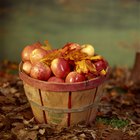
gpointstudio/iStock/Getty Images
A shift to an organic diet eliminates unnecessary chemicals and pesticides in your food. If your pantry is full of regular food, the switch to organic foods might seem daunting. Breaking down the transition into smaller steps makes it more manageable without being organizationally and financially overwhelming. A smart approach to starting an organic lifestyle allows you to keep the costs lower, which is often a factor that holds consumers back from organic products.
Inspect your refrigerator and food storage areas before each trip to the grocery store to ensure you have the room to store the produce. Plan for more frequent trips to the store if you want fresh produce, as the organic versions don't typically last as long. Purchase organic frozen fruits and vegetables as a backup if you cannot go to the market frequently.
Clean out any rotten produce from your refrigerator to make room for fresh, organic fruits and vegetables. Write a list of the produce you tossed and items that are getting low. Add pantry items to the list that are getting low.
Purchase the organic version of the items on the list to replace your current supply that is low or gone. Gradually replace all of your staples in the pantry with organic varieties as they run low. This avoids waste because you aren't throwing out your regular items and it stretches out the financial commitment of going organic.
Switch to organic for produce with thin skin or items that are consumed without peeling, such as berries, apples, celery, bell peppers, greens, peaches and potatoes. Hold off on produce with thicker skins that are peeled, such as bananas, avocado, pineapple, mango and melons, if you cannot afford to immediately switch to all organic.
Convert to organic milk and diary products to eliminate artificial hormones, antibiotics and pesticides. While organic milk is significantly more expensive than regular milk, DrGreene.com suggests the switch helps support a more natural, organic agricultural system.
Purchase organic, hormone-free meat and eggs if you include this form of protein in your diet. Organic meat is often one of the more expensive organic switches.
Purchase organic condiments, seasonings and other flavorings as they fit into the budget.
Read the labels to determine if a product is certified USDA organic, which means no pesticides, synthetic fertilizers or ionizing radiation are used, according to the United States Department of Agriculture. Look for "100 percent organic" to indicate that all ingredients are organic, "organic" for 95 percent organic ingredients and "Made with Organic Ingredients" for at least 70 percent organic ingredients with no genetically modified organisms.
Shop around at different stores to find the best selection and prices on organic food. Look at your favorite grocery stores, both in the organic section and the regular aisles, as some organic foods are placed next to the nonorganic foods. Try health food stores, membership stores and other types of stores that sell food, as well as farmer's markets, CSAs and your own garden.
Call local restaurants to determine if they offer organic food options. Some regular restaurants offer some organic dishes, but keep in mind that they might use oils, seasonings and other components that aren't organic. A specialty restaurant offering only organic foods is a more reliable option if there is one available in your area.
Related Articles

10 Worst Non-Organic Foods

How to Make Organic Shoe Polish

Summer Youth Activities for Low Income ...

How to Avoid Fermented Foods

How to Open an Online Bridal Store

How to Keep Lunch Meat

List of Biodegradable, Every Day ...

How to Break in a Backpack

How to Start Your Own Business Sewing ...

Health Benefits of Organic Foods Vs. ...

What Is an Alkaline Ash Diet?

How to Legally Change Your Name When ...

Hydroponic Vegetable Nutrients Vs. ...

How to Replace the Battery in a ...

How to Get the Stains Out of White ...

How to Carry Heavy Laptops
How to Visit the White House

How to Take Care of Rubber Boots

How to Substitute Dry Milk for ...

How to Purchase Milk Crates
References
Writer Bio
Shelley Frost writes professionally on a full-time basis, specializing in lifestyle, family, parenting and relationship topics. She holds an education degree and has extensive experience working with kids and parents.
Photo Credits
gpointstudio/iStock/Getty Images